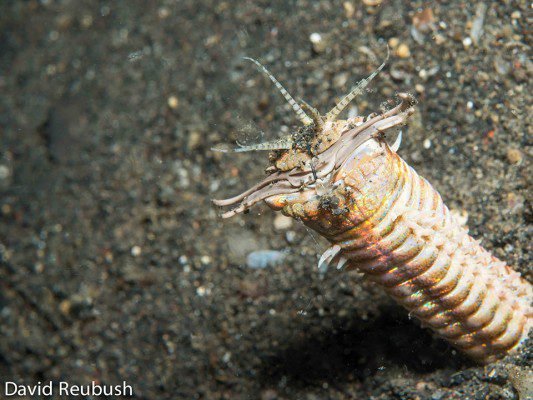
Bobbit worms are fascinating creatures that can grow quite large, often hidden in the sand and rock crevices of the ocean floor. Their long, segmented bodies can be both mesmerizing and a bit intimidating. On the other hand, cleaner shrimp are the small, friendly critters that make a living by “cleaning” parasites off fish, almost like little underwater groomers. So, what happens when these two come into contact? Let’s dive deeper into their potential coexistence and uncover what an aquarium enthusiast might need to know.
Understanding Bobbit Worms
Bobbit worms, known scientifically as *Eunice aphroditois*, are marine polychaete worms. They’re often found in the sandy substrates of tropical waters, where they blend into their surroundings. Their long, segmented bodies can reach lengths of up to 10 feet, although you typically see them around 3 feet in captivity. With their impressive jaws, they can catch small fish and crustaceans, making them effective predators.
You might be wondering about their behavior. Bobbit worms are **predatory** and generally remain hidden until they sense prey nearby. When they do, they strike with lightning speed, pulling their meals into their burrows. This means they might not be the best roommates in an aquarium setting filled with smaller fish and critters that could fall onto their dinner menu.
Getting to Know Cleaner Shrimp
Now, let’s shift gears and look at cleaner shrimp. These little guys, often belonging to the *Lysmata* genus, are known for their vibrant colors and friendly nature. They play a vital role in maintaining the health of the aquarium by eating parasites and dead tissue off fish. In their natural habitat, you’ll often see them perched on larger fish, ready to provide a much-needed grooming session.
Cleaner shrimp are considered more social than many fish species. They thrive best in community tanks, where they can engage with different fish, enhancing the tank’s dynamics. If you have a reef setup, adding them can create an interactive environment—think of them as the “service crew” of your aquatic ecosystem.
The Potential for Conflict
Here’s the thing: while Bobbit worms and cleaner shrimp might seem like they each have their unique niches, their coexistence can be problematic. Bobbit worms are opportunistic predators. If a cleaner shrimp ventures too close to their lair, it might become a meal.
Imagine you’re at a party, and one guest is known for taking too many snacks. That’s kind of how the Bobbit worm operates—it’s always on the lookout for an easy meal. Cleaner shrimp might not realize the danger lurking beneath the sand, which puts them at risk in an aquarium setting where Bobbit worms are present.
Tank Conditions for Coexistence
If you’re set on trying to keep Bobbit worms and cleaner shrimp together, it’s crucial to pay attention to your tank conditions. Here are a few things to consider:
- Tank Size: A larger tank with plenty of space might help lessen the chances of conflict. A 50-gallon tank or larger can provide enough room for both to find their niches.
- Habitat Layout: Create a complex environment with plenty of hiding places. Use rocks, caves, and other structures to give cleaner shrimp safe zones where they won’t accidentally wander into danger.
- Feeding Strategy: Ensure you’re offering ample food for both species. If the cleaner shrimp are satiated, they may be less likely to venture too close to the worm’s lair.
Remember, while it’s possible to set up a harmonious tank, it’s essential to monitor their interactions closely.
The Ethics of Co-housing
Every aquarium enthusiast has their own philosophy about what’s ethical when it comes to species housing. Some might argue against placing a potentially predatory species like the Bobbit worm with harmless critters like cleaner shrimp. Not only does this raise concerns for the shrimp’s safety, but it also influences the natural behaviors of both species.
If you’re an advocate for a thriving ecosystem that doesn’t inadvertently put any animal at risk, you might opt to keep these two separate. A species-specific tank can often lead to healthier and happier creatures.
Alternatives to Consider
If you’re deciding against keeping Bobbit worms and cleaner shrimp together, there are other options to explore. Here are some alternatives:
- Cleaner Gobies: These small fish can perform a similar role to cleaner shrimp while being less likely to become prey for Bobbit worms.
- Other Shrimp Species: Look into shrimp species that can coexist with larger tank inhabitants, like peppermint shrimp, which are often more robust in terms of survival.
- Invertebrates: Consider snails or other invertebrates that help maintain the tank’s health without the risk of predation.
By diversifying your tank’s inhabitants, you can create a more balanced ecosystem that thrives without conflict.
Final Thoughts on Bobbit Worms and Cleaner Shrimp
In the end, whether Bobbit worms can coexist with cleaner shrimp boils down to understanding both creatures’ roles and behaviors. While they can live in the same tank under the right conditions, the risk to the cleaner shrimp makes this pairing quite tricky.
So, if you’re willing to take on the challenge, be proactive about creating a safe, well-structured environment. But if you’re looking for a harmonious community tank, you might want to think twice about including a Bobbit worm. Sometimes, the best decisions come from respecting the natural order of things and prioritizing the well-being of all your aquatic friends.
